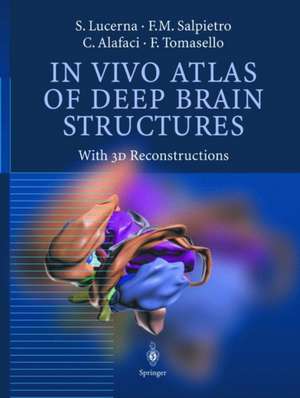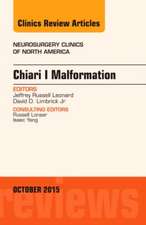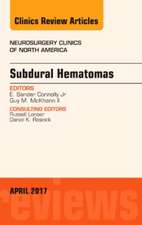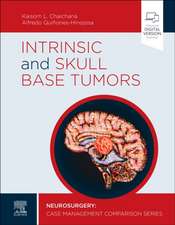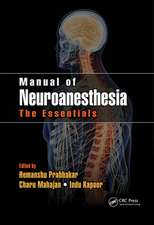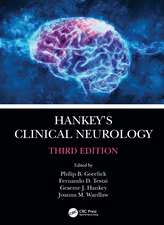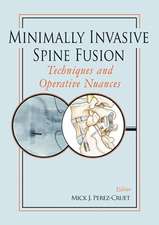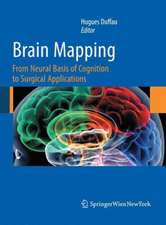In Vivo Atlas of Deep Brain Structures: With 3D Reconstructions
Autor S. Lucerna, F.M. Salpietro, C. Alafaci, F. Tomaselloen Limba Engleză Hardback – 29 ian 2002
| Toate formatele și edițiile | Preț | Express |
|---|---|---|
| Paperback (1) | 354.38 lei 6-8 săpt. | |
| Springer Berlin, Heidelberg – 5 oct 2012 | 354.38 lei 6-8 săpt. | |
| Hardback (1) | 746.45 lei 39-44 zile | |
| Springer Berlin, Heidelberg – 29 ian 2002 | 746.45 lei 39-44 zile |
Preț: 746.45 lei
Preț vechi: 785.74 lei
-5% Nou
Puncte Express: 1120
Preț estimativ în valută:
132.13€ • 153.85$ • 115.39£
132.13€ • 153.85$ • 115.39£
Carte tipărită la comandă
Livrare economică 19-24 ianuarie 26
Preluare comenzi: 021 569.72.76
Specificații
ISBN-13: 9783540425618
ISBN-10: 3540425616
Pagini: 176
Ilustrații: VII, 165 p.
Dimensiuni: 210 x 279 x 17 mm
Greutate: 0.97 kg
Ediția:2002
Editura: Springer Berlin, Heidelberg
Colecția Springer
Locul publicării:Berlin, Heidelberg, Germany
ISBN-10: 3540425616
Pagini: 176
Ilustrații: VII, 165 p.
Dimensiuni: 210 x 279 x 17 mm
Greutate: 0.97 kg
Ediția:2002
Editura: Springer Berlin, Heidelberg
Colecția Springer
Locul publicării:Berlin, Heidelberg, Germany
Public țintă
Professional/practitionerCuprins
The Reference System: The ca-cp Plane.- MRI Technique.- Magnified 2D Plate Reconstructions.- Spatial Limits and Magnification Factors.- Drawing Technique.- 3D Plate Reconstructions: NURBS Modeling.- Example of How To Use the Atlas.- Axial Sections: Plates 1–17.- Coronal Sections: Plates 18–40.- Sagittal Sections: Plates 41–54.- 3D Reconstructions.- Combination of All Structures.- Putamen, Globus Pallidus Medialis and Lateralis, Ansa Lenticularis.- Caudate Nucleus, Putamen, Globus Pallidus Medialis and Lateralis, Ansa Lenticularis.- The Thalamic Region.- The Amygdala, Fornix and Periventricular Regions.
Recenzii
From the reviews:
"This colour atlas of deep brain nuclei and other structures will prove to be a useful aid to both the functional neurosurgeon and the discerning neuroradiologist. ... The in vivo image capture, obtained with MRI, provides a more accurate view of these deep-seated neuroanatomical structures, making it superior to those atlases based on cadaveric imaging. Consequently, this atlas will prove useful both in the operating theatre and reporting room alike. The atlas is well organized and easy to navigate." (R.A. Trivedi, European Radiology, Vol. 14 (8), 2004)
"This is a 3D atlas of brain structures acquired from MRI of normal volunteers, produced by the Department of Neurosurgery in Messina, Italy. … it is truly a pictorial atlas. … The 3D images are impressive and well produced technically … . In summary, this atlas may have most appeal to neurosurgeons but is a useful refresher for neuroradiologists … ." (P.White, Neuroradiology, Vol. 44 (11), 2002)
"This colour atlas of deep brain nuclei and other structures will prove to be a useful aid to both the functional neurosurgeon and the discerning neuroradiologist. ... The in vivo image capture, obtained with MRI, provides a more accurate view of these deep-seated neuroanatomical structures, making it superior to those atlases based on cadaveric imaging. Consequently, this atlas will prove useful both in the operating theatre and reporting room alike. The atlas is well organized and easy to navigate." (R.A. Trivedi, European Radiology, Vol. 14 (8), 2004)
"This is a 3D atlas of brain structures acquired from MRI of normal volunteers, produced by the Department of Neurosurgery in Messina, Italy. … it is truly a pictorial atlas. … The 3D images are impressive and well produced technically … . In summary, this atlas may have most appeal to neurosurgeons but is a useful refresher for neuroradiologists … ." (P.White, Neuroradiology, Vol. 44 (11), 2002)
Caracteristici
Useful millimetric scale and highest possible precision of the images make the atlas an ideal tool for surgical planning Superb quality of 4-color 2D and 3D reconstructions
